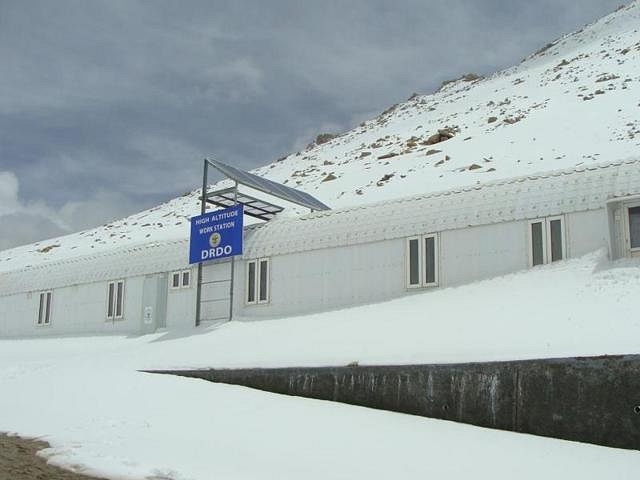Insta
DRDO’s DIHAR Main Attraction At Top Global Human Physiology Conference

DRDO’s high altitude work station.
Catering to the well-being of Indian soldiers deployed in high-altitude areas with extreme weather conditions, a research station has been set up by India’s premier research organisation – the Defence Research and Development Organisation (DRDO) – last year at an altitude of 17,660 feet at Chang La in Jammu and Kashmir.
This DRDO research station, which is the world’s highest terrestrial research and development (R&D) centre, was established by the Defence Institute of High Altitude Research (DIHAR), Leh, a constituent establishment of DRDO.
Leading experts turned up when DIHAR was talked about at a recent international conference on human physiology – "FIPSPHYSIOCON 2017” that was organised by Defence Institute of Physiology and Allied Science (DIPAS) of DRDO and was inaugurated at Vallabhbhai Patel Chest Institute, University of Delhi. DIPAS is the only physiology research centre in the country.
Speaking at the event, chairman DRDO and Department of Defence Research and Development secretary Dr S Christopher urged the entire scientific community to utilise the facilities of this research station.
Dr Christopher also highlighted the importance of Yoga and other approaches to improve human capabilities in difficult environmental conditions and terrains.
The centre is sitting in the cold desert of Ladakh, where the temperature goes as low as -40 degrees Celsius during extreme winter months, coupled with reduced atmospheric pressure and humidity besides high wind velocity and ultra violet radiation.
The station can accommodate up to 10 scientists along with a support staff of 10, and has fully-equipped state-of-the-art laboratories. Solar power is the primary source of energy with back-up support by diesel generators.
It is concentrating on R&D work in frontal areas of food and agriculture and bio-medical sciences for the well-being of soldiers deployed in high-altitude cold desert.
Activities of this centre include human physiological work, long-term conservation of plant genetic resources, designing, testing, validation and demonstration of mobile and portable greenhouses, soil-less micro-farming technologies for fresh food in remote landlocked posts, besides conservation and propagation of endangered extreme altitude medicinal plants and others.
Besides undertaking life sciences activities it may provide unique opportunity to other labs and establishments of DRDO for testing and evaluation of electronics and communication devices, testing of materials for high altitude applications, batteries, fuel cells, unmanned aerial vehicle’s micro engines among others.
On his part, DIPAS Director and convener of the conference Dr Bhuvnesh Kumar deliberated the importance of the theme, “Integrating Physiological and Biomedical Science Approaches to Improve Performance, Health and Safety” and various topics of the conference in speeches, keynote addresses, plenary sessions – 16 sessions, 118 lectures and 140 posters – by the 300 delegates from India, the US, the UK, Kyrgyz Republic and Malaysia.
Physiologists Society of India (PSI) president Professor Amar K Chandra highlighted the necessity of the formation of the Federation of Indian Physiological Societies (FIPS) by combining PSI, Society for Animal Physiologists of India, Association of Physiologists and Pharmacologists of India, Indian Society for Comparative Animal Physiology and its role in facilitating the scientific interaction between physiologists in India and their international counterparts.
Distinguished scientist and DRDO life sciences director general and FIPS president Dr Shashi Bala Singh in her address focused on optimisation of physical performance with interdisciplinary approaches. She also cited the unique mechanism of human body system by emphasising on different important aspects like sophisticated neural processing and energy requirements of human brain. She highlighted the collaborative approaches not only within the physiological sciences but also in a broader spectrum involving physical sciences and engineering.
Support Swarajya's 50 Ground Reports Project & Sponsor A Story
Every general election Swarajya does a 50 ground reports project.
Aimed only at serious readers and those who appreciate the nuances of political undercurrents, the project provides a sense of India's electoral landscape. As you know, these reports are produced after considerable investment of travel, time and effort on the ground.
This time too we've kicked off the project in style and have covered over 30 constituencies already. If you're someone who appreciates such work and have enjoyed our coverage please consider sponsoring a ground report for just Rs 2999 to Rs 19,999 - it goes a long way in helping us produce more quality reportage.
You can also back this project by becoming a subscriber for as little as Rs 999 - so do click on this links and choose a plan that suits you and back us.
Click below to contribute.
Latest